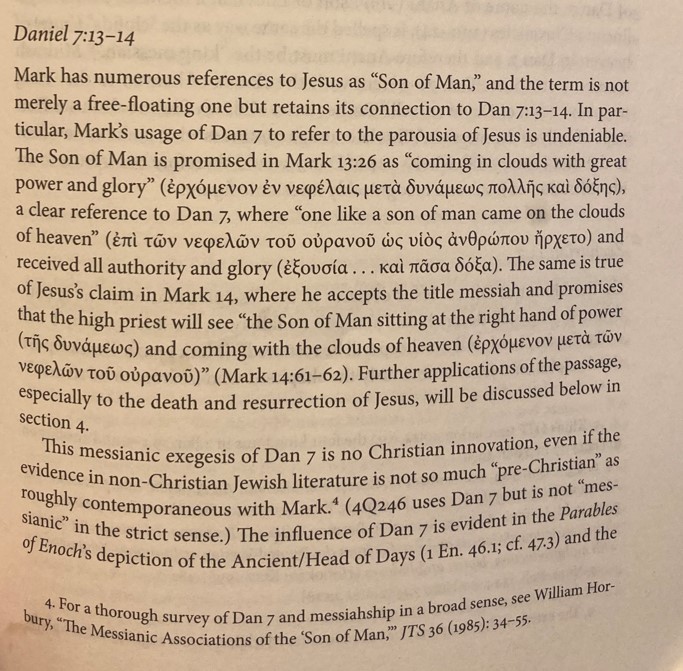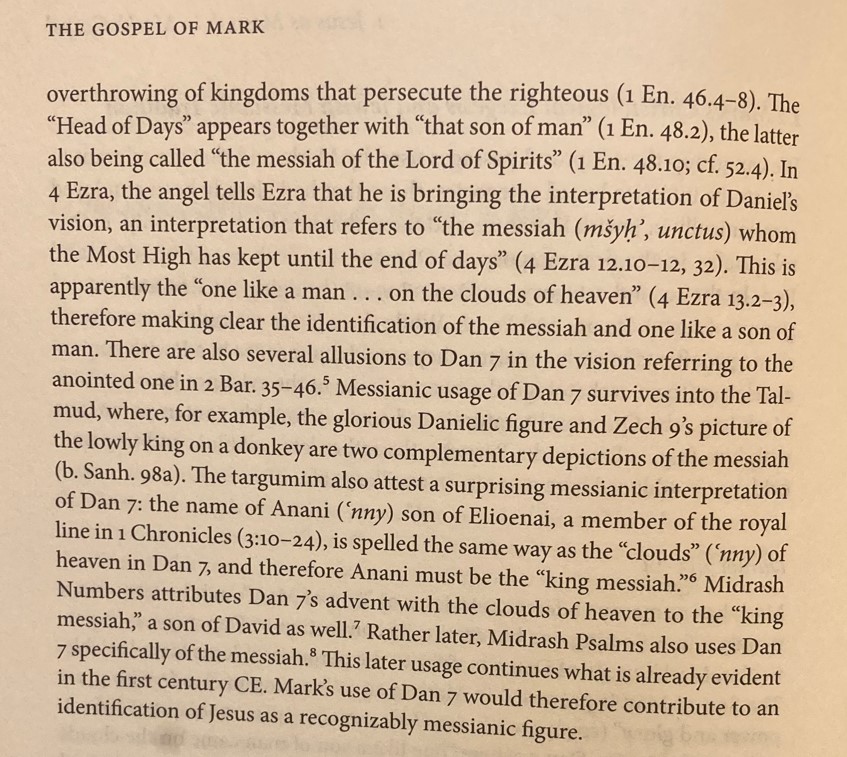Simon Gathercole notes that Mark's use of Daniel 7 to depict Jesus as the Son of Man and the Messianic has parallels in contemporary literature such as 1 Enoch.
- Type
- Book
- Source
- Simon Gathercole Non-LDS
- Hearsay
- DirectSecondary
- Reference
Simon Gathercole, The Gospel and the Gospels: Christian Proclamation and Early Jesus Books (Grand Rapids, Mich.: Eerdmans, 2022), 83-84
- Scribe/Publisher
- Eerdmans
- People
- Simon Gathercole
- Audience
- Reading Public
- Transcription
Daniel 7:13-14
Mark has numerous references to Jesus as “Son of Man,” and the term is not merely a free-floating one but retains its connection to Dan 7:13-14. In particular, Mark’s usage of Dan 7 to refer to the parousia of Jesus is undeniable. The Son of Man is promised in Mark 13:26 as “coming in clouds with great power and glory” (ἐρχόμενον ἐν νεφέλαις μετὰ δυνάμεως πολλῆς καὶ δόξης), a clear reference to Dan 7, where “one like a son of man came on the clouds of heaven” (επι των ωεφελων του ουρανου ως υιος ανθρωπου ηρχετο) and received all authority and glory (εξουσια . . . και πασα δοξα). The same is true of Jesus’s claim in Mark 14, where he accepts the title messiah and promises that the high priest will see “the Son of Man sitting on the right hand of power (της δυναμεως) and coming with the clouds of heaven (ερχομενον μετα των νεφελων του ουρανου)” (Mark 14:61-62). Further applications of the passage, especially to the death and resurrection of Jesus, will be discussed below in section 4.
This messianic exegesis of Dan 7 is no Christian innovation, even if the evidence in non-Christian Jewish literature is not so much “pre-Christian” as roughly contemporaneous with Mark. (4Q246 uses Dan 7 but is not “messianic” in the strict sense.) The influence of Dan 7 is evident in the Parables of Enoch’s depiction of the Ancient/Head of Days (1 En. 46.1; cf. 47.3) and the overthrowing of kingdoms that persecute the righteous (1 En. 46.4-8). The “Head of Days” appears together with “that son of man” (1 En. 48.2), the latter also being called “the messiah of the Lord of Spirits” (1 En. 48.10; cf. 52.4). In 4 Ezra, the angel tells Ezra that he is bringing the interpretation of Daniel’s vision, an interpretation that refers to “the messiah (mšyḥ’, unctus) whom the Most High has kept until the end of days” (4 Ezra 12.10-12, 32). This is apparently the “one like a man . . . on the clouds of heaven” (4 Ezra 13.2-3), therefore making clear the identification of the messiah and the one like a son of man. There are several allusions to Dan 7 in the vision referring to the anointed one in 2 Bar. 35-46. Messianic usage of Dan 7 survives into the Talmud, where, for example, the glorious Danielic figure and Zech 9’s picture of the lowly king on a donkey are two complementary depictions of the messiah (b. Sanh. 98a). The targumim also attest a surprising messianic interpretation of Dan 7: the name of Anani (‘nny) son of Elioneai, a member of the royal line in 1 Chronicles (3:10-24) is spelled the same way as the ”clouds” (‘nny) of heaven in Dan 7, and therefore Anani must be the “king messiah.” Midrash Numbers attributes Dan 7’s advent with the clouds of heaven to the “king messiah,” a son of David as well. Rather later, Midrash Psalms also uses Dan 7 specifically of the messiah. This later usage continues what is already evident in the first century CE. Mark’s use of Dan 7 would therefore contribute to an identification of Jesus as a recognizably messianic figure.
- Citations in Mormonr Qnas
The B. H. Roberts Foundation is not owned by, operated by, or affiliated with the Church of Jesus Christ of Latter-day Saints.


